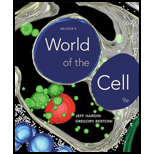
Why do scientists currently believe that RNA, rather than DNA, was the informational molecule in the first cells?
To determine: The reason the scientists believe RNA and not DNA to be the informational molecule in the first cells.
Introduction: Cell is the basic “fundamental unit” of life. Cells can either be unicellular or multicellular. The organisms with one cell are referred to as unicellular organisms, whereas the organisms with more than one cell are termed as multicellular organisms. The genetic information is passed on from one generation to the next with the help of genes.
Explanation of Solution
According to the central dogma, the information is transcribed from DNA to RNA and then it is finally translated from RNA into proteins. DNA acts as an informational molecule and in order to transfer information it needs to get replicated. DNA replication takes place with the help of certain pre-existing enzymes which are produced with the help of information found in DNA. Monomer subunits of RNA are responsible for producing monomer subunits of DNA with the help of certain enzymes. Ribozymes are catalytic RNAs which help in RNA replication without the requirement of enzymes whose information is found in DNA.
Therefore, this is the main reason that the scientists think that RNA and not DNA was the informational molecule in first cells as formation of certain enzymes which help in the production of DNA has been done from the information encoded within the DNA and RNA subunits act as precursors for enzymatic production of building blocks of DNA as ribozymes assist in RNA replication without the requirement of enzymes encoded by DNA.
Want to see more full solutions like this?
Chapter 4 Solutions
Becker's World of the Cell (9th Edition)
- In one paragraph show how atoms and they're structure are related to the structure of dna and proteins. Talk about what atoms are. what they're made of, why chemical bonding is important to DNA?arrow_forwardWhat are the structure and properties of atoms and chemical bonds (especially how they relate to DNA and proteins).arrow_forwardThe Sentinel Cell: Nature’s Answer to Cancer?arrow_forward
- Molecular Biology Question You are working to characterize a novel protein in mice. Analysis shows that high levels of the primary transcript that codes for this protein are found in tissue from the brain, muscle, liver, and pancreas. However, an antibody that recognizes the C-terminal portion of the protein indicates that the protein is present in brain, muscle, and liver, but not in the pancreas. What is the most likely explanation for this result?arrow_forwardMolecular Biology Explain/discuss how “slow stop” and “quick/fast stop” mutants wereused to identify different protein involved in DNA replication in E. coli.arrow_forwardMolecular Biology Question A gene that codes for a protein was removed from a eukaryotic cell and inserted into a prokaryotic cell. Although the gene was successfully transcribed and translated, it produced a different protein than it produced in the eukaryotic cell. What is the most likely explanation?arrow_forward
- Molecular Biology LIST three characteristics of origins of replicationarrow_forwardMolecular Biology Question Please help. Thank you For E coli DNA polymerase III, give the structure and function of the b-clamp sub-complex. Describe how the structure of this sub-complex is important for it’s function.arrow_forwardMolecular Biology LIST three characteristics of DNA Polymerasesarrow_forward
 Human Biology (MindTap Course List)BiologyISBN:9781305112100Author:Cecie Starr, Beverly McMillanPublisher:Cengage Learning
Human Biology (MindTap Course List)BiologyISBN:9781305112100Author:Cecie Starr, Beverly McMillanPublisher:Cengage Learning
 Human Heredity: Principles and Issues (MindTap Co...BiologyISBN:9781305251052Author:Michael CummingsPublisher:Cengage Learning
Human Heredity: Principles and Issues (MindTap Co...BiologyISBN:9781305251052Author:Michael CummingsPublisher:Cengage Learning Concepts of BiologyBiologyISBN:9781938168116Author:Samantha Fowler, Rebecca Roush, James WisePublisher:OpenStax College
Concepts of BiologyBiologyISBN:9781938168116Author:Samantha Fowler, Rebecca Roush, James WisePublisher:OpenStax College Biology: The Dynamic Science (MindTap Course List)BiologyISBN:9781305389892Author:Peter J. Russell, Paul E. Hertz, Beverly McMillanPublisher:Cengage Learning
Biology: The Dynamic Science (MindTap Course List)BiologyISBN:9781305389892Author:Peter J. Russell, Paul E. Hertz, Beverly McMillanPublisher:Cengage Learning





